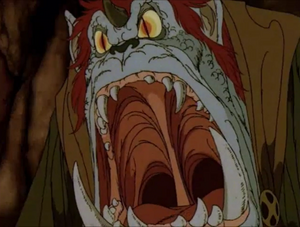(Summary taken from Wikipedia)
The Hobbit is a 1977 American animatedmusical television specialcreated by Rankin/Bass, a studio known for their holiday specials, and animated by Top Craft, a precursor to Studio Ghibli. The film is an adaptation of the 1937 book of the same name by J. R. R. Tolkien, and was first broadcast on NBC in the United States on Sunday, November 27, 1977.
 The film was produced and directed by Arthur Rankin, Jr. and Jules Bass of Rankin/Bass Productions and was adapted for the screen by Romeo Muller, with Rankin taking on the additional duties of production designer. When interviewed for the film, Rankin declared that he would add nothing to the story that wasn't in the original.[2] The New York Times reported that The Hobbit cost $3 million.[2]
The film was produced and directed by Arthur Rankin, Jr. and Jules Bass of Rankin/Bass Productions and was adapted for the screen by Romeo Muller, with Rankin taking on the additional duties of production designer. When interviewed for the film, Rankin declared that he would add nothing to the story that wasn't in the original.[2] The New York Times reported that The Hobbit cost $3 million.[2]
The story's hero, Bilbo Baggins, is voiced by Orson Bean, backed up by noted Hollywood director and actor John Huston as the voice of Gandalf. In supporting roles, the comedian and performance artist Brother Theodore was chosen for the voice of Gollum, and Thurl Ravenscroft performed the baritone singing voices of the goblins. The gravelly voice of the dragon Smaugwas provided by Richard Boone, with Hans Conried as Thorin Oakensheild, rounding out the cast of primarily American voice actors.
The Hobbit was animated by Topcraft, a now-defunct Japanese animation studio whose animation team would re-form as Studio Ghibli under Hayao Miyazaki. Topcraft successfully partnered with Rankin/Bass on several other co-productions, including The Last Unicorn. According to Rankin, the visual style of the film took its basic cue from the early illustrations of Arthur Rackham.[2]
While Topcraft produced the animation, the concept artwork was completed in the US under the direction of Arthur Rankin.[2] The Rhode Island-based artist Lester Abrams did the initial designs for most of the characters; Rankin had seen Abrams' illustrations to an excerpt from The Hobbitin Children's Digest.[3] Principal artists included coordinating animator Toru Hara; supervising animator/character designer Tsuguyuki Kubo; character and effects animators Hidetoshi Kaneko and Kazuko Ito; and background designer Minoru Nishida. The same studio and crew members were also used for The Return of the King.
Harry N. Abrams published a large coffee-table illustrated edition of the book featuring concept art and stills.[2]
The Hobbit is a 1977 American animatedmusical television specialcreated by Rankin/Bass, a studio known for their holiday specials, and animated by Top Craft, a precursor to Studio Ghibli. The film is an adaptation of the 1937 book of the same name by J. R. R. Tolkien, and was first broadcast on NBC in the United States on Sunday, November 27, 1977.

The story's hero, Bilbo Baggins, is voiced by Orson Bean, backed up by noted Hollywood director and actor John Huston as the voice of Gandalf. In supporting roles, the comedian and performance artist Brother Theodore was chosen for the voice of Gollum, and Thurl Ravenscroft performed the baritone singing voices of the goblins. The gravelly voice of the dragon Smaugwas provided by Richard Boone, with Hans Conried as Thorin Oakensheild, rounding out the cast of primarily American voice actors.
The Hobbit was animated by Topcraft, a now-defunct Japanese animation studio whose animation team would re-form as Studio Ghibli under Hayao Miyazaki. Topcraft successfully partnered with Rankin/Bass on several other co-productions, including The Last Unicorn. According to Rankin, the visual style of the film took its basic cue from the early illustrations of Arthur Rackham.[2]
While Topcraft produced the animation, the concept artwork was completed in the US under the direction of Arthur Rankin.[2] The Rhode Island-based artist Lester Abrams did the initial designs for most of the characters; Rankin had seen Abrams' illustrations to an excerpt from The Hobbitin Children's Digest.[3] Principal artists included coordinating animator Toru Hara; supervising animator/character designer Tsuguyuki Kubo; character and effects animators Hidetoshi Kaneko and Kazuko Ito; and background designer Minoru Nishida. The same studio and crew members were also used for The Return of the King.
Harry N. Abrams published a large coffee-table illustrated edition of the book featuring concept art and stills.[2]
Last edited:





